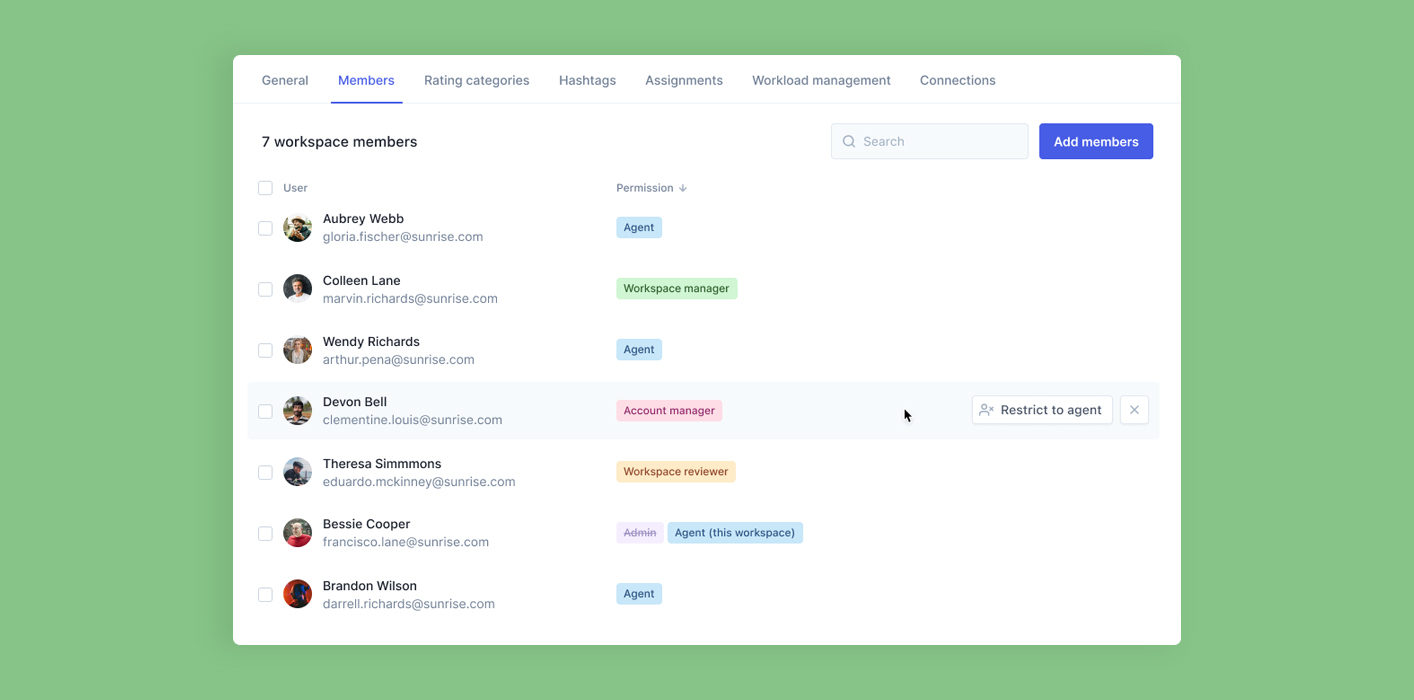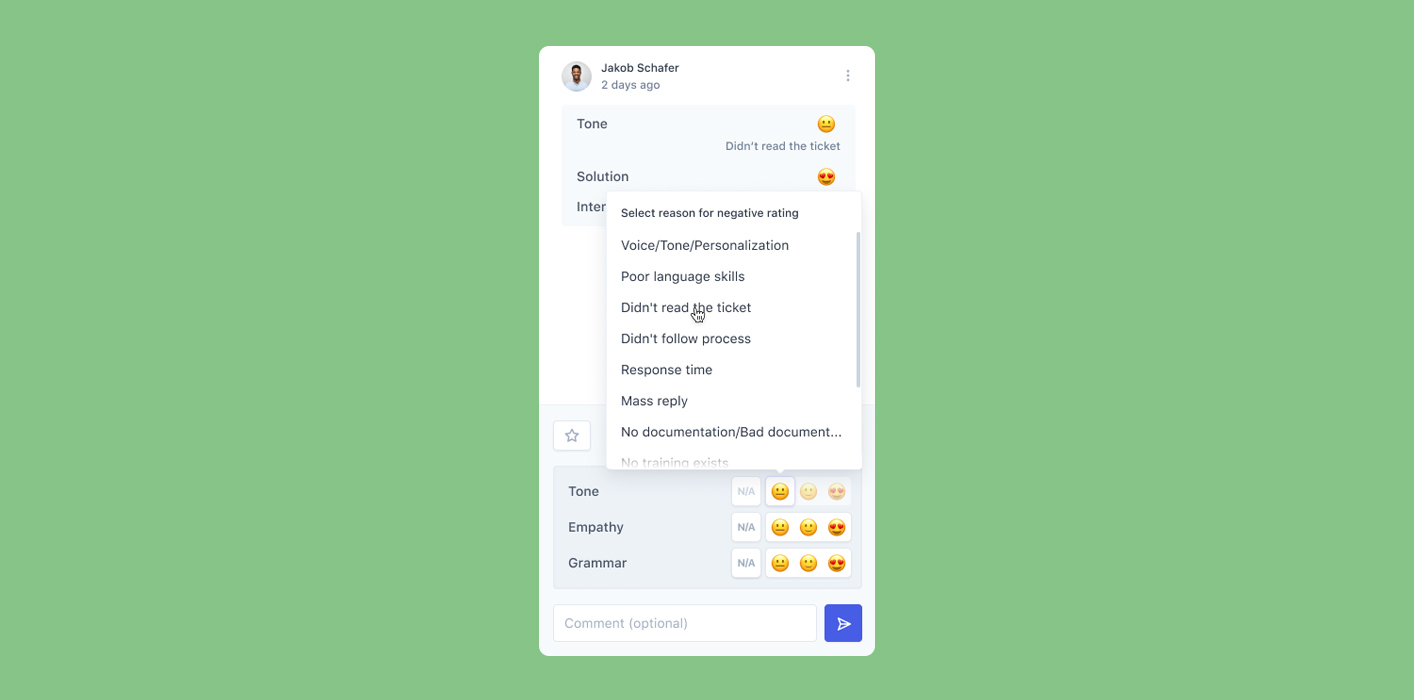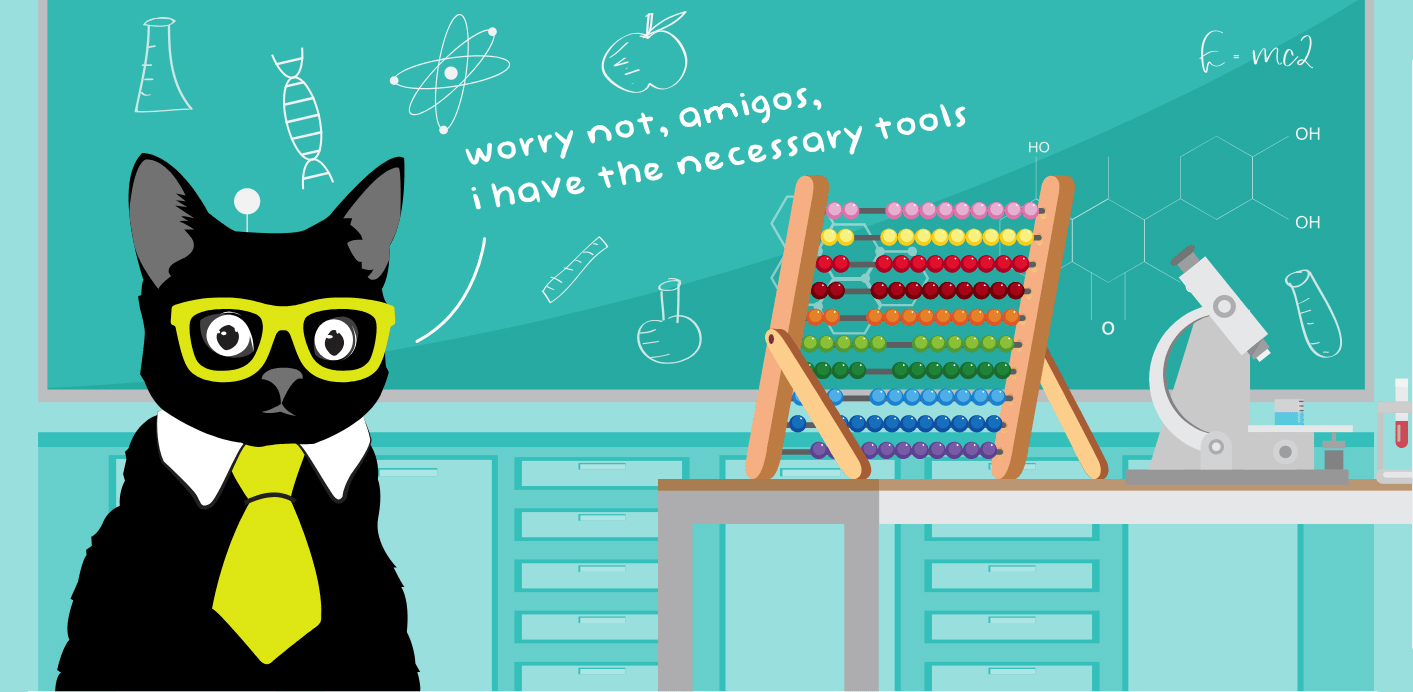Trying to keep track of your support quality?
As your business grows and support operations become more complex, you might find manual reviews and using spreadsheets cumbersome for reviewing customer interactions.
Teams often review countless support conversations monthly, wanting quick access to details like ticket numbers, dates, and URLs. If this tracking is tedious and unenjoyable, the feedback quality drops. This is where customer support quality management tools step in.
What is a customer support quality management tool?
Customer support quality management tools allow you to monitor the quality of customer interactions, train and onboard agents, and improve your support operations.
Customer support quality management tools are also referred to as customer service quality assurance software, conversation review tools, customer service quality control platforms, or quality monitoring software.

When do you need customer support quality management software?
So, does every organization need a support quality management platform? Well, no.
But does every organization need a way to systematically review support interactions? Absolutely!
All quality-oriented customer support teams will, sooner or later, find themselves in a paw-sition where they need to start assessing the quality of their support interactions by doing internal conversation reviews. Quality gets harder to manage as you scale. And there is no other way of knowing whether your agents deliver the same customer experiences across multiple channels.
So, the question is not whether or not to do conversation reviews — it’s how to do them.
If you’re in the early stages of starting with QA, with just a few users, you’re probably using some combination of spreadsheets, Slack, and email to do conversation reviews.
And the process might be just fine for now if:
1. You can structure all of the following data in a way that’s comprehensible to your whole team:
- ticket name, date, time, content;
- agent’s response, date, time, content;
- reviewer’s name, date;
- rating categories (e.g., product knowledge, tone, solution);
- rating scales;
- comments and suggestions;
- total internal assessment score.
2. You have a well-defined system to give feedback where your agents read the feedback they’re receiving.
3. You can create meaningful charts and reports that help you identify trends and actionable insights.
If you’ve established a system where you can do all of the above without having to spend too much time or do excessive manual work, then you’re probably good for now. However…
✨ If the quality monitoring process isn’t fun, the reviews won’t get done. ✨

Why do you need a customer support quality management tool?
The ultimate goal of a support quality management platform is to help you improve the quality of your support by making the process of conversation reviews systematic and easy.
And this results in…
Precision in onboarding and training
To provide the best support possible to your customers, you’ll need your agents to excel at their job. And this can only be possible by providing them with relevant and timely feedback.
For example, if you notice a lot of your agents struggling with certain technical questions, you could devote more time to this during onboarding or hold an education session to bring everybody up to speed.
Or if you notice issues with a certain agent’s communication style, you might leave notes on how they can improve upon it or schedule a one-to-one meeting with them.
Consistency across your support team
While there are probably several customer service metrics you monitor, you’ll find that the majority of them are your customers’ perceptions of the support they receive.
But it’s equally important to track your team’s performance against internal quality standards — with an Internal Quality Score.
Using a support quality management tool helps you establish a shared definition of what good customer service is and align your entire support team with company-wide goals.
Eliminating the need for manual work
If you’re reading this it’s clear that you’re serious about improving the quality of your customer support. And that means you’re performing conversation reviews in some form or the other.
But doing so without a dedicated tool means you’re most likely copy-pasting vast amounts of data. And you’re probably constantly having to remind agents to look at the feedback they’re receiving.
A good support quality management tool eliminates the need for manual work. The process of reviewing conversations, giving feedback, and notifying agents can be seamlessly done from a single dashboard — and even automated, depending on the tool you’re using.
Identifying trends and actionable insights quickly
If you don’t know how you’re performing, it’s hard to improve. And that’s where customer support quality management really comes in handy.
It processes vast amounts of data and shows relevant insights, so you can see areas where your support team is excelling, where there’s room for improvement, and ones that need your immediate attention. All at a glance.

What to consider when picking support quality management software?
Alright, so it appears that your existing way of doing support QA could use an upgrade. Whether that’s making the switch from spreadsheets or another software that doesn’t quite cut it for you.
Here’s a checklist with different criteria you should consider while selecting support quality monitoring software:
- Does the tool have an integration with your existing helpdesk?
- Does it have all the features you need?
- Does it have integrations with the software you regularly use?
- Does it have pricing that matches your budget?
- Will it still be useful as you scale your support operations?
- Is the software easy to use?
- What security and compliance measures have been taken?
- Are they accessible and responsive in customer support?
Help desk (and other) integrations
You want to make sure that the customer service quality monitoring tool can integrate with the existing tech stack you’re using. Whether that’s just help desk integration like Intercom, Zendesk, and LiveAgent, or any other solution (for example, Slack for receiving notifications when reviews are done).
This will ensure you can access and review data from a single screen eliminating the need to constantly switch tabs or manually copy-paste data. Better yet, if the quality management software has a browser extension, you’d be able to review customer conversations in the help desk solution.
Check the QA tool’s integrations page to see if there’s already an existing integration. While building custom integrations is possible, this will take time and act as an unnecessary hurdle to getting started immediately. You should only consider this if the QA software is head and shoulders above the other alternatives you’re considering.

Key features
The best customer support quality management platforms offer powerful features that will help you run your QA program. Consider looking at the following:
Customizable scorecards
According to Customer Service Quality Benchmark Report 2023, the most popular cat-egories used by customer service professionals are:
- Solution
- Grammar
- Tone
- Empathy
- Personalization
- Following internal processes
- Going the extra mile
No matter which ones you choose, you need a QA tool that will help you build and customize multiple scorecards that reflect your own internal quality standards and customer service goals.
Apart from selecting your own categories, you’ll want to be able to adjust the weighting of the different categories to demonstrate what is most important to your company, and how much they should contribute to the overall score. Look for software that gives you the flexibility to choose a rating scale (from binary ratings to scales with scores of up to 5 or more) that works best for your team.

Grading calibration
To get meaningful results from conversation reviews, you’ll need to ensure consistency in the review process. That is, different reviewers similarly grading all support conversations.
A QA calibration feature helps you ensure just that. And while there are multiple calibration strategies, the end goal remains the same. Consistency.
So how does it work?
Most commonly, different reviewers will review the same set of tickets without seeing how others have been grading them. So that they can do so in an unbiased manner.
This way you’ll be able to see firsthand if there are major discrepancies in the way tickets are being reviewed.
This is then followed up with the reviewers discussing their reasons and thought processes together. So that a consensus can be reached. Which ultimately prevents such disparities in the future.
User roles and permissions
You’ll want to set different user roles and permissions for the members of your team based on how you want them to use the QA software.
For example, here’s what you may want different team members to be able to do:
- Agents: View their own tickets, access statistics, and reply to received feedback.
- QA specialists: Review other agents’ tickets and view general statistics about the entire workspace.
- Customer service team leads: Set up rating categories, assign roles, and view detailed statistics about each agent & reviewer separately.
- Head of customer support: Manage all workspaces, edit all workspaces’ settings and managers’ roles.
- Account owner: Everything including managing payments, editing all account roles, or deleting accounts.

Root cause analysis
Another important aspect of improving your support is identifying the root cause of negative interactions.
Here’s how it can work:
Every time there’s a negative rating for a category, the reviewer will be prompted to either write a comment or choose a reason from a predefined list.
This allows you to gather more in-depth feedback on the root causes of why a category received a negative rating. So that you can take the necessary corrective action to address it.

Dashboards and reporting
A major part of using support QA software is to be able to view large amounts of data in an organized manner.
Here are some things you’ll want your tool to show you:
- Agent performance against your internal quality standards
- How much your key customer service metrics like Internal Quality Score (IQS) and Customer Satisfaction Score (CSAT) are changing from month to month
- How many tickets are being reviewed
- How your agents are performing across the different categories of your scorecard
And you’ll want to make sure you can view all these reports in the way you’d like to see them whether that’s in a tabular form, line graphs, or something else.

Automation & artificial intelligence
The last set of features you’ll want to check for are ones powered by AI and machine learning that can help your team save time and effort.
For example, with a sentiment analysis feature, you can filter out all the tickets in which the customer sentiment is judged to have been either paw-sitive or negative.
AutoQA, on the other hand, can help you achieve 100% coverage with automated scoring across multiple categories and languages, no matter the number of agents and support interactions.
User experience
The software you select will be used by your team on a day-to-day basis. So it’s of paramount importance that it’s easy and enjoyable to use.
And there’s no better way to find out than by taking advantage of a free trial. Here’s what you’ll want to check for when you’re trying out the tool:
- Is it easy to figure out while getting started?
- Is it fast and intuitive?
- Can you see your team using it on a daily basis?
- How much training and onboarding will be required?
- What are the training resources available to bring your team up to speed?
A complicated interface or workflow usually means that the quality of feedback will suffer. Which ends up defeating the purpose of using such a tool.
Reliability and compliance
It’s important to find out if the makers of the product:
- have implemented organizational and technical controls that ensure the safety of your data
- have clear internal policies
- follow a detailed onboarding process for employees
- provide regular security training
- You can check for this by going to the company’s security page on their website.
Learn what processes they have in place and which certifications they possess to make sure there’ll be no issues with security or compliance. Some keywords to look for include SOC 2, GDPR, and OAuth.

Pricing
There are tools to suit every budget.
And you can find pricing for different support QA software ranging from free to $50 per agent/month.
But to add some context, support teams on average spend $184 on software per agent every month with approximately $29 of this accounting for their QA tool.
So once you’ve identified the tool with the features and integrations you need, you can eliminate software that doesn’t have pricing that matches your budget. Which helps you further narrow down your list.
Scalability
Different tools are built for different-sized teams.
But a factor that often gets missed when selecting QA software is scalability.
Perhaps a certain tool might be a good fit for you right now. But will it continue to be when you hire a lot of seasonal staff? Or when your operations eventually scale?
So in addition to finding out if the tool fits your team’s current needs, make sure it can do just as well in the future as your team grows.
Go through different case studies to see how the tool has worked for companies in a similar position as you’re in (or you’re planning to be in).
Support
Lastly, the provider you go with must be accessible and responsive when you reach out to them for support.
Go through their profile on review sites like G2 where others leave unbiased opinions on their experience with their support team (and the product as a whole).

Which are the best support quality management tools?
Finally, it’s time to look at the best software available in the market to help you choose the one that will work for you:
- Zendesk QA (formerly Klaus)
- MaestroQA
- Playvox
- EvaluAgent
- Scorebuddy
- Miuros
- Observe.AI
- Kaizo
- Summatti
- Aprikot
- Loris
- Medallia
- Sprinklr
For a more detailed overview, head to Top Customer Service Quality Assurance Software: Comparison →

And we’re done!
Perhaps you’ve realized spreadsheets just aren’t enough. Or maybe you’re considering switching from one support QA tool to another due to missing features, cost, or service quality. Regardless, delivering top-notch support is key to a stellar customer experience, and overall customer satisfaction. The need for comprehensive customer support QA tools will eventually arise in your journey.
Originally published in July 2021; last updated in August 2023.




